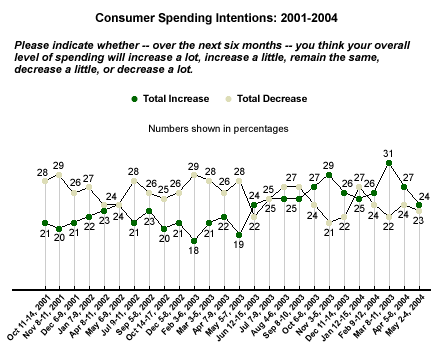A May 2-4 Gallup Poll* shows consumer spending intentions declining for the second month in a row. Twenty-four percent of U.S. consumers say they plan to increase their spending over the next six months, while 23% plan to decrease their spending -- a difference of only one percentage point. This represents a decline from April when the difference was three points in favor of increasing spending.
More importantly, consumer spending intentions have been declining since March, when they hit their highest level observed since Gallup began tracking them in October 2001. In March, the difference between the percentage of consumers planning to increase spending (31%) and the percentage planning to decrease spending (22%) reached nine percentage points.

Although small sample sizes limit the conclusions that we can draw about consumer spending intentions by income, the May survey results suggest that more consumers in the higher-income brackets plan to increase their spending rather than decrease it. On the other hand, more lower-income consumers plan to decrease their spending rather than increase it. Still, the difference between higher-income and lower-income consumers is less pronounced in May than it was in April.
Bottom Line
Declining consumer spending intentions are no surprise given falling consumer confidence and surging gas prices, which hit another new record last week. Oil prices reached nearly $40 a barrel last week, and despite the promise by the Saudis' to increase production, at this point, the peak in gas prices is nowhere in sight.
For many Americans, gas is an essential commodity that they must purchase in order to get to work and maintain their lifestyles. The inelasticity of demand for gas tends to make an increase in its price work much like a sales tax increase would. As a result, consumers have less money to spend on other consumer goods.
Gallup's consumer confidence data suggest that upper-income consumers remain more optimistic than their lower-income counterparts. So far, this confidence seems to translate into a continuation in upper-income consumer spending intentions -- but higher prices and rising interest rates are beginning to bite. If current trends continue, it is not at all clear that non-energy-related consumer spending will meet expectations during the second half of the year.
*Results are based on telephone interviews with 1,000 national adults, aged 18 and older, conducted May 2-4, 2004. For results based on the total sample of national adults, one can say with 95% confidence that the margin of sampling error is ±3 percentage points.
